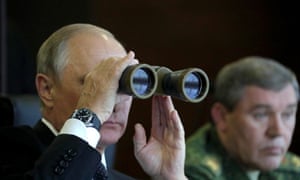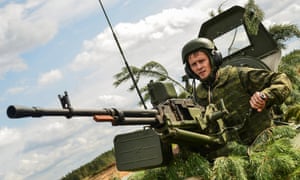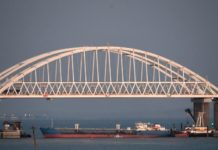A large-scale Russian military exercise that has spooked western countries has entered its final phase, with helicopters, fighter jets, missiles and tanks employed at a firing range close to Russia’s border with the EU.
Vladimir Putin was among those watching the 45-minute display of firepower on a cold and rainy Monday afternoon at the Luga firing range, about 70 miles (113km) from the border with EU member state Estonia. The Russian president, joined by the defence minister, Sergei Shoigu, and a number of army generals, watched through binoculars from a viewing platform.
The scenario for Zapad, which Russia is holding jointly with the armed forces of neighbouring Belarus, sees Veishnoria, a fictitious region of Belarus, declare independence and attempt to turn Belarus against Russia, with the help of Nato countries.
Putin observes the Zapad 2017 military exercise. Photograph: Anadolu Agency/Getty Images
As the world frets over Russia’s ability to conduct “hybrid warfare” using cyber-attacks, proxies and fake news, Zapad is a reminder of the country’s hard military power.
Exercises have also taken place in Belarus and Russia’s Baltic exclave of Kaliningrad. On Monday the exercise transitioned from defence to counterattack, with infantry, artillery, missile, air defence and aviation all involved. According to the scenario, the Veishnorian separatists had seized a number of planes and drones from the government and had to be destroyed.
Zapad, which means “west” in Russian, is the reincarnation of a Soviet-era training exercise that involved Warsaw Pact countries, and is carried out every four years. This year’s training has caused particular alarm in the west, with some observers believing it to be the biggest military drill Russia has held since the end of the cold war.
Russian officials have denied the exercises are anything other than a standard training exercise, and point to Nato troop buildup in central and eastern Europe as the real threat to stability on the continent. A 4,000-member multinational Nato force has been deployed in the Baltics and Poland to counter the Russian threat.
Russia claims only 12,700 troops are taking part in the exercises, which brings them in just under the 13,000 threshold, over which there would be a requirement under a treaty known as the Vienna document to allow western observers to attend. Russia has invited a number of diplomatic observers and says all the fears are misplaced.
“We reject complaints of these exercises not being transparent,” Putin’s spokesman, Dmitry Peskov, told reporters last week. “We believe that whipping up hysteria around these exercises is a provocation.”
According to the scenario of the drills, the supposed separatists of Veishnoria are backed by two fictitious countries, Lubenia and Vesbaria, which appear to be thinly disguised references to Poland and Lithuania.
A Belarusian soldier in a tank taking part in Zapad 2017. Photograph: Igor Rudenko/Defense Ministry/EPA
Nato officials say the drills are meant as a warning to the alliance that Russia can mass a large number of troops at short notice, while the three Baltic countries have voiced particular alarm.
Others have suggested that becoming so alarmed by the exercises plays into Russia’s hands, giving Moscow an exaggerated threat level. However, Baltic states point to the 2013 Zapad exercises that came shortly before the annexation of Crimea and intervention in East Ukraine.
Lithuania’s defence minister, Raimundas Karoblis, suggested there was even a risk of the drill triggering a conflict or being used as cover to leave behind troops in Belarus. “We can’t be totally calm. There is a large foreign army massed next to Lithuanian territory,” he told Reuters.
The US army moved 600 paratroopers to the Baltic states for the duration of Zapad, and has taken charge of guarding the air space of the three countries.
The exercises have been taking place in a number of locations in the western part of Russia and Belarus. Earlier on Monday, the Russian military said Sukhoi Su-24 bombers practised a strike on ground targets in difficult weather conditions, dropping 250kg bombs on simulated enemy fortifications.
Later at Luga, the poor weather continued, with driving rain and low rolling clouds obscuring the view of an Ilyushin 76 plane that dropped paratroopers into the drill with cover from fighter jets. Artillery and missile systems and dozens of tanks were also used.
On the other side of the country, a group of four Chinese ships has arrived in the Russian Pacific port of Vladivostok for joint naval exercises, which come as tension rises over North Korea.
Source: theguardian.com












